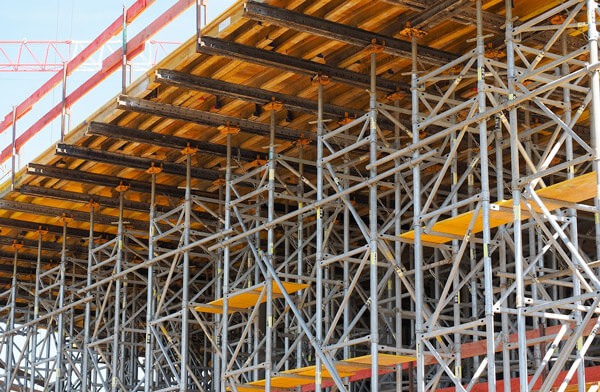Scaffold checklist
If you work with scaffolding here is some great information to keep and refer to as/when needed.
This guide is intended to clarify when a scaffold design is required and what level of training and competence those erecting, dismantling, altering, inspecting and supervising scaffolding operations are expected to have.
Scaffold design
It is a requirement of the Work at Height Regulations 2005 that unless a scaffold is assembled to a generally recognised standard configuration, eg NASC Technical Guidance TG20 for tube and fitting scaffolds or similar guidance from manufacturers of system scaffolds, the scaffold should be designed by bespoke calculation, by a competent person, to ensure it will have adequate strength, rigidity and stability while it is erected, used and dismantled.
At the start of the planning process, the user should supply relevant information to the scaffold contractor to ensure an accurate and proper design process is followed. Typically this information should include:
- site location
- period of time the scaffold is required to be in place
- intended use
- height and length and any critical dimensions which may affect the scaffold
- number of boarded lifts
- maximum working loads to be imposed and maximum number of people using the scaffold at any one time
- type of access onto the scaffold eg staircase, ladder bay, external ladders
- whether there is a requirement for sheeting, netting or brickguards
- any specific requirements or provisions eg pedestrian walkway, restriction on tie locations, inclusion/provision for mechanical handling plant eg hoist)
- nature of the ground conditions or supporting structure
- information on the structure/building the scaffold will be erected against together with any relevant dimensions and drawings
- any restrictions that may affect the erection, alteration or dismantling process.
Prior to installation, the scaffold contractor or scaffold designer can then provide relevant information about the scaffold. This should include:
- type of scaffold required (tube & fitting or system)
- maximum bay lengths
- maximum lift heights
- platform boarding arrangement (i.e. 5 + 2) and the number of boarded lifts that can be used at any one time
- safe working load / load class
- maximum leg loads
- maximum tie spacing both horizontal and vertical and tie duty
- details of additional elements such as beamed bridges, fans, loading bays etc, which may be a standard configuration (see note 1 ref TG20:13) or specifically designed
- information can be included in relevant drawings if appropriate
- any other information relevant to the design, installation or use of the scaffold
- reference number, date etc. to enable recording, referencing and checking.

All scaffolding must be erected, dismantled and altered in a safe manner. This is achieved by following the guidance provided by the NASC in document SG4 ‘Preventing falls in scaffolding’ for tube and fitting scaffolds or by following similar guidance provided by the manufacturers of system scaffolding.
For scaffolds that fall outside the scope of a generally recognised standard configuration the design must be such that safe erection and dismantling techniques can also be employed throughout the duration of the works. To ensure stability for more complex scaffolds, drawings should be produced and, where necessary, these may need to be supplemented with specific instructions.
Any proposed modification or alteration that takes a scaffold outside the scope of a generally recognised standard configuration should be designed by a competent person and proven by calculation.
Scaffold structures that normally require bespoke design
Includes:
- all shoring scaffolds (dead, raking, flying)
- cantilevered scaffolds
- truss-out Scaffolds
- façade retention
- access scaffolds with more than the 2 working lifts
- buttressed free-standing scaffolds
- temporary roofs and temporary buildings
- support scaffolds
- complex loading bays
- mobile and static towers
- free standing scaffolds
- temporary ramps and elevated roadways
- staircases and fire escapes (unless covered by manufacturers instructions)
- spectator terraces and seating stands
- bridge scaffolds
- towers requiring guys or ground anchors
- offshore scaffolds
- pedestrian footbridges or walkways
- slung and suspended scaffolds
- protection fans
- pavement gantries
- marine scaffolds
- boiler scaffolds
- power line crossings
- lifting gantries and towers
- steeple scaffolds
- radial / splayed scaffolds on contoured facades
- system scaffolds outside manufacturers guidance
- sign board supports
- sealing end structures (such as temporary screens)
- temporary storage on site
- masts, lighting towers and transmission towers
- advertising hoardings/banners
- rubbish chute
- any scaffold structure not mentioned above that falls outside the ‘compliant scaffold’ criteria in TG20 or similar guidance from manufacturers of system scaffolds.
The above list is not exhaustive and any scaffold that is not a standard configuration or does not comply with published manufacturers’ guidelines will require a specific design produced by a competent person.
Note:
- TG20:13 provides compliant scaffolds for a limited range of cantilever scaffolds, loading bays, static towers, use of rakers, bridges and protection fans.
- TG20:13 provides a range of compliant scaffolds, which can be boarded at any number of lifts, but only two platforms can be used as working platforms at any one time.
Competence and supervision of scaffolding operatives
All employees should be competent for the type of scaffolding work they are undertaking and should have received appropriate training relevant to the type and complexity of scaffolding they are working on.
Employers must provide appropriate levels of supervision taking into account the complexity of the work and the levels of training and competence of the scaffolders involved.
As a minimum requirement, every scaffold gang should contain a competent scaffolder who has received training for the type and complexity of the scaffold to be erected, altered or dismantled.
Trainee scaffolders should always work under the direct supervision of a trained and competent scaffolder. Operatives are classed as ‘trainees’ until they have completed the approved training and assessment required to be deemed competent.
Erection, alteration and dismantling of all scaffolding structures (basic or complex) should be done under the direct supervision of a competent person. For complex structures this would usually be an ‘Advanced Scaffolder’ or an individual who has received training in a specific type of system scaffold for the complexity of the configuration involved.
Scaffolding operatives should be up to date with the latest changes to safety guidance and good working practices within the scaffolding industry. Giving operatives job specific pre-start briefings and regular toolbox talks is a good way of keeping them informed.
Scaffold inspection
It is the scaffold users / hirers responsibility to ensure that all scaffolding has been inspected as follows:
- following installation or before first use
- at an interval of no more than every 7 days thereafter
- following any circumstances liable to jeopardise the safety of the installation eg high winds.
All scaffolding inspection should be carried out by a competent person whose combination of knowledge, training and experience is appropriate for the type and complexity of the scaffold. Competence may have been assessed under the CISRS or an individual may have received training in inspecting a specific type of system scaffold from a manufacturer/supplier.
A non-scaffolder who has attended a scaffold inspection course (eg a site manager) could be deemed competent to inspect a basic scaffold structure.
The scaffold inspection report should note any defects or matters that could give rise to a risk to health and safety and any corrective actions taken, even when those actions are taken promptly, as this assists with the identification of any recurring problem.
I hope this helps, but as always if you need any help please contact us today on 07770 302504 or email joanne@chestnutassociates.co.uk


